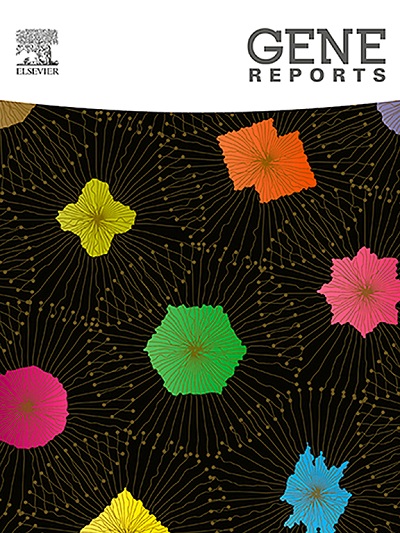RORA polymorphisms are associated with ischemic stroke
IF 1
Q4 GENETICS & HEREDITY
引用次数: 0
Abstract
Introduction
RAR Related Orphan Receptor A (RORA) encodes a nuclear hormone receptor that participates in the pathoetiology of several disorders.
Objective
We aimed to evaluate association between two RORA variants (rs11639084 and rs4774388) and risk of ischemic stroke among Iranians.
Methods
These polymorphisms were genotyped using 4P-ARMS-PCR method.
Results
The rs11639084 polymorphism was associated with risk of stroke in all assumed inheritance models. T allele of this polymorphism was identified as the risk allele increasing the risk of ischemic stroke with OR (95 % CI) of 18.64 (13.58–25.57), P < 0.0001 and AIC = 29.4. Notably, the TT genotype was found to increase risk of this condition compared with CC genotype (OR (95 % CI) = 309.6 (142.2–683.2)) and CC + TC genotypes (OR (95 % CI) = 62.37 (30.06–129.4)). Since AIC estimates the quality of each model relative to other models, allelic model seems to be the best model for appraisal of the association between rs11639084 and risk of ischemic stroke. The rs4774388 polymorphism was associated with risk of stroke in all assumed inheritance models, except for over-dominant model. C allele of this polymorphism was reported to be the risk allele increasing the risk of ischemic stroke with OR (95 % CI) of 8.56 (6.4–11.43), P < 0.0001 and AIC = 29.6. Accordingly, the CC genotype increased susceptibility to ischemic stroke compared with TT genotype (OR (95 % CI) = 22.4 (14.6–42.5)), as well as combination of the other two genotypes (OR (95 % CI) = 12.92 (8.18–20.4)). Similar to the other polymorphism, the highest AIC value belonged to the allelic model.
Conclusions
In brief, we showed associations between two RORA polymorphisms and susceptibility to ischemic stroke in Iranian population. RORA might be the functional link between abnormality in circadian rhythm and risk of ischemic stroke. Moreover, this gene might explain the shared genetic background between obesity and stroke.
RORA多态性与缺血性中风有关
rar相关孤儿受体A (RORA)编码一种参与多种疾病病理的核激素受体。目的:我们旨在评估两种RORA变异(rs11639084和rs4774388)与伊朗人缺血性卒中风险之间的关系。方法采用4P-ARMS-PCR方法对这些多态性进行基因分型。结果rs11639084多态性在所有假设的遗传模型中均与卒中风险相关。该多态性的T等位基因被确定为增加缺血性卒中风险的危险等位基因,OR (95% CI)为18.64 (13.58 ~ 25.57),P <;0.0001, AIC = 29.4。值得注意的是,TT基因型与CC基因型(OR (95% CI) = 309.6(142.2-683.2))和CC + TC基因型(OR (95% CI) = 62.37(30.06-129.4))相比,发现该疾病的风险增加。由于AIC评估了每个模型相对于其他模型的质量,因此等位基因模型似乎是评估rs11639084与缺血性卒中风险相关性的最佳模型。在所有假设的遗传模型中,rs4774388多态性与卒中风险相关,除了过显性模型。据报道,该多态性的C等位基因是增加缺血性卒中风险的危险等位基因,OR (95% CI)为8.56 (6.4-11.43),P <;0.0001, AIC = 29.6。因此,与TT基因型相比,CC基因型增加了缺血性卒中的易感性(OR (95% CI) = 22.4(14.6-42.5)),其他两种基因型的组合(OR (95% CI) = 12.92(8.18-20.4))。与其他多态性相似,AIC值最高的是等位基因模型。总之,我们发现了两个RORA多态性与伊朗人群缺血性卒中易感性之间的关联。RORA可能是昼夜节律异常与缺血性卒中风险之间的功能联系。此外,这个基因或许可以解释肥胖和中风之间的共同遗传背景。
本文章由计算机程序翻译,如有差异,请以英文原文为准。
求助全文
约1分钟内获得全文
求助全文
来源期刊

Gene Reports
Biochemistry, Genetics and Molecular Biology-Genetics
CiteScore
3.30
自引率
7.70%
发文量
246
审稿时长
49 days
期刊介绍:
Gene Reports publishes papers that focus on the regulation, expression, function and evolution of genes in all biological contexts, including all prokaryotic and eukaryotic organisms, as well as viruses. Gene Reports strives to be a very diverse journal and topics in all fields will be considered for publication. Although not limited to the following, some general topics include: DNA Organization, Replication & Evolution -Focus on genomic DNA (chromosomal organization, comparative genomics, DNA replication, DNA repair, mobile DNA, mitochondrial DNA, chloroplast DNA). Expression & Function - Focus on functional RNAs (microRNAs, tRNAs, rRNAs, mRNA splicing, alternative polyadenylation) Regulation - Focus on processes that mediate gene-read out (epigenetics, chromatin, histone code, transcription, translation, protein degradation). Cell Signaling - Focus on mechanisms that control information flow into the nucleus to control gene expression (kinase and phosphatase pathways controlled by extra-cellular ligands, Wnt, Notch, TGFbeta/BMPs, FGFs, IGFs etc.) Profiling of gene expression and genetic variation - Focus on high throughput approaches (e.g., DeepSeq, ChIP-Seq, Affymetrix microarrays, proteomics) that define gene regulatory circuitry, molecular pathways and protein/protein networks. Genetics - Focus on development in model organisms (e.g., mouse, frog, fruit fly, worm), human genetic variation, population genetics, as well as agricultural and veterinary genetics. Molecular Pathology & Regenerative Medicine - Focus on the deregulation of molecular processes in human diseases and mechanisms supporting regeneration of tissues through pluripotent or multipotent stem cells.
 求助内容:
求助内容: 应助结果提醒方式:
应助结果提醒方式:


